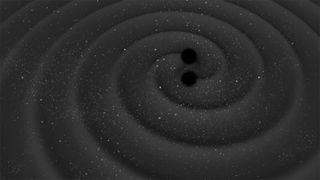Binary pairings of small black holes could be used by astronomers in a cosmic game of “hide-and-seek” to hunt much larger, yet more elusive, supermassive black hole binaries. The technique could, therefore, help solve the mystery of how supermassive black holes grew so fast in the early universe.
Detecting black holes is no easy task despite their reputation as fearsome cosmic titans. All black holes are surrounded by a one-way light-trapping boundary called an “event horizon” that ensures they emit no light. Even the supermassive black holes at the hearts of galaxies with masses millions or billions of times that of the sun are only “visible” if they are feasting on a vast amount of surrounding matter or if they are ripping apart an unfortunate star.
However, light, or “electromagnetic radiation” as it is more accurately known, is only one type of radiation. Another is “gravitational radiation,” which comes in the form of tiny ripples that set spacetime humming called “gravitational waves,” which humanity is just beginning to detect. That means rather than looking for supermassive black hole pairs in this game of hide-and-seek, astronomers can listen for them instead.
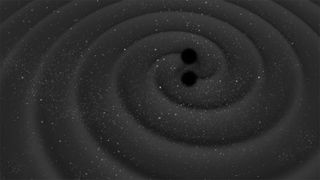
“Our idea basically works like listening to a radio channel. We propose to use the signal from pairs of small black holes similar to how radio waves carry the signal,” team leader Jakob Stegmann, a postdoctoral research fellow at the Max Planck Institute for Astrophysics, said in a statement. “The supermassive black holes are the music that is encoded in the frequency modulation (FM) of the detected signal.”
Related: Cracking! Some binary black holes may roll around each other in egg-shaped orbits
Small black hole sing soprano
Gravitational waves are a concept that was first suggested by Albert Einstein in general relativity, his 1915 magnum opus theory of gravity.
General relativity suggests that gravity arises when an object with mass “warp” the very fabric of space and time, which Einstein had previously united as a single four-dimensional entity (three spatial dimensions, one dimension of time) called “spacetime.”
The bigger the mass, the greater the extremity of the curvature of space an object creates. That explains why planets have a bigger gravitational influence than moons, why stars have a bigger influence than planets, and why black holes have the biggest influence of any single object.
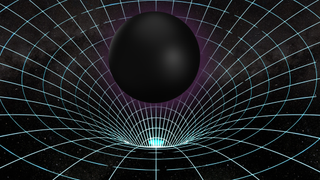
Einstein also predicted that when objects accelerate in spacetime, they set its fabric “ringing” with ripples or gravitational waves. These are completely insignificant for objects with low masses, but when black holes orbit around each other (remembering that circular motion is acceleration), they have enough mass to generate significant gravitational waves.
As these black holes spiral around each other, they emit continuous low-frequency gravitational waves. These gravitational waves carry away angular momentum (or spin), forcing the black holes together, a process called “inspiralling.” This increases the frequency of the gravitational waves, thus causing angular momentum to be carried away faster and faster.
That is until the black holes finally collide and merge, an event that sends out a higher frequency “scream” of gravitational waves.
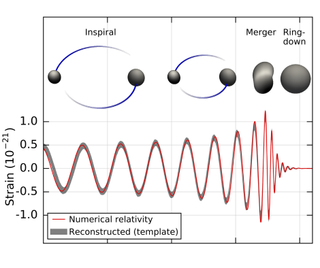
Even so, Einstein predicted that these spacetime ripples would be too faint to ever detect, especially as they would lose energy as they propagated through the cosmos and black hole mergers occur millions or even billions of light-years away.
Fortunately, we now know Einstein was wrong.
Since the detection of the first gravitational wave signal by the Laser Interferometer Gravitational-Wave Observatory (LIGO) in 2015, which originated from a binary black hole merger 1.3 billion light-years away, many such black hole collisions have been detected.
But these detections have one thing in common. When they involved black holes, they were always pairs in the stellar-mass black hole range, with masses between three and a few hundred times that of the sun. Supermassive black hole mergers have been elusive for terrestrial gravitational wave detectors like LIGO and its compatriots VIRGO in Italy and the Kamioka Gravitational Wave Detector (KAGRA) in Japan.
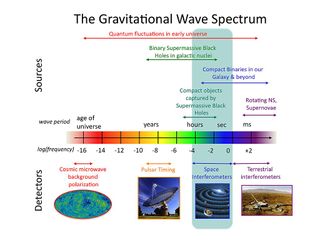
Just as our ears have evolved to hear certain frequencies of sound and not others, these instruments can only detect a certain frequency range of gravitational waves. The gravitational waves emitted by swirling pairs of supermassive black holes are too low-frequency for terrestrial gravitational wave detectors to “hear.”
In other words, with their gravitational waves, stellar-mass binaries sing soprano, while supermassive pairings sing baritone.
This team proposes detecting the subtle change in gravitational waves from stellar-mass black hole binaries that are caused by interfering gravitational waves from supermassive binaries.
These small modulations could, therefore, help reveal supermassive black hole mergers that are currently only detectable as a collective “background hum” using vast collections of rapidly spinning neutron stars called a “pulsar timing array.”
“The novel aspect of this idea is to utilize high frequencies that are easy to detect to probe lower frequencies that we are not sensitive to yet,” Stegmann said.
RELATED STORIES:
The proposal could also help direct the design of future gravitational wave detectors, such as the upcoming NASA and European Space Agency (ESA) space-based detector LISA (Laser Interferometer Space Antenna).
“As the path for the LISA is now set, after adoption by ESA last January, the community needs to evaluate the best strategy for the following generation of gravitational wave detectors,” team member and University of Zurich black hole theorist Lucio Mayer said. “In particular, which frequency range they should target – studies like this bring a strong motivation to prioritize a deci-Hz [low-frequency] detector design.”
The team’s research was published on Monday (August 5) in the journal Nature.
